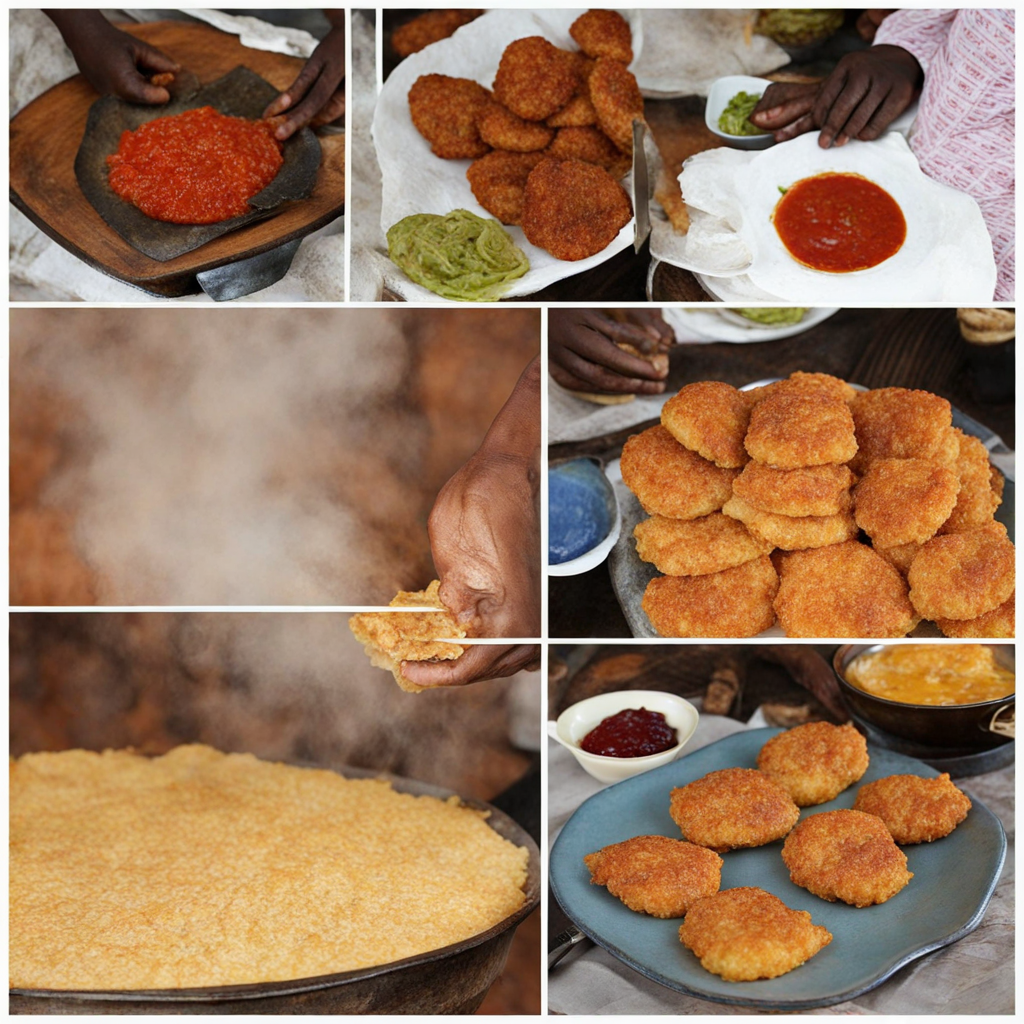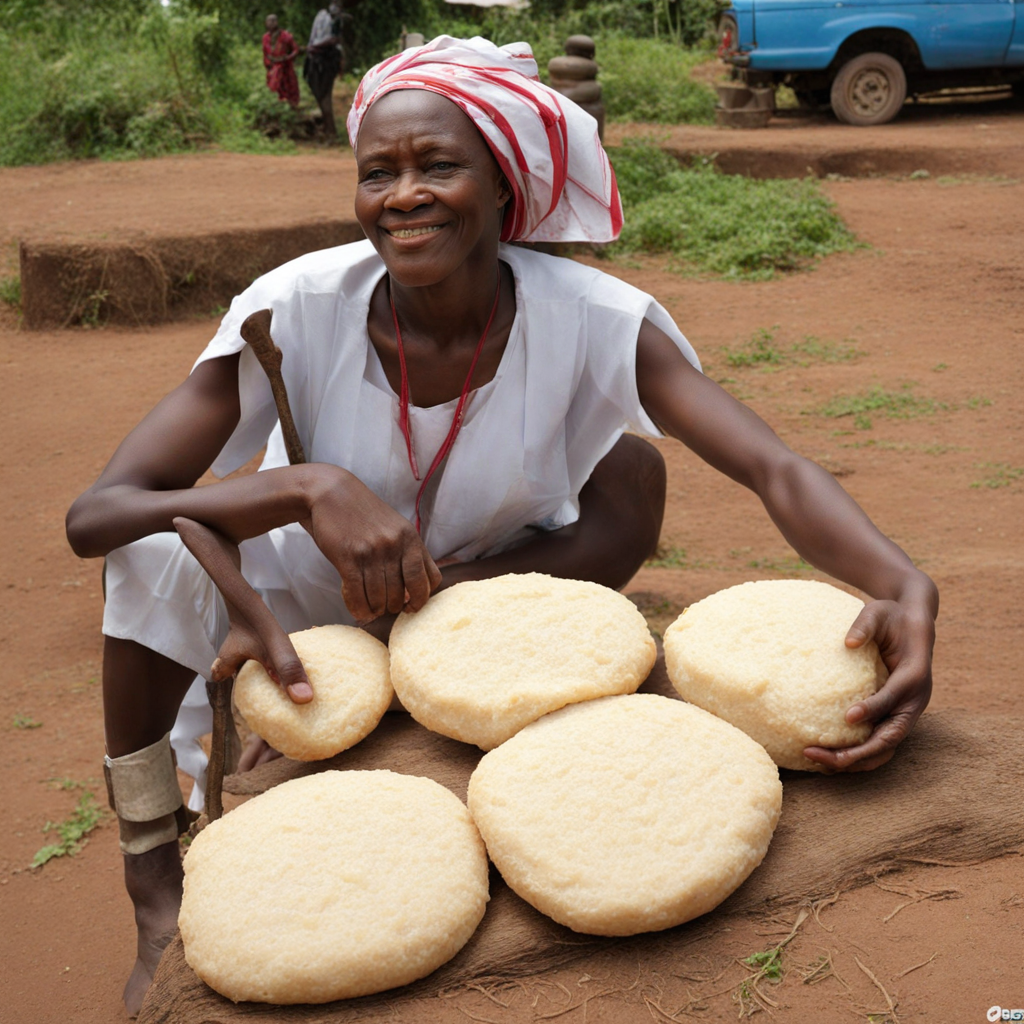Yovo Doko
Yovo Doko is a delightful dish originating from the heart of the Congo, characterized by its unique blend of textures and flavors. At its core, Yovo Doko features a base of cassava, which is a staple in many African cuisines. The cassava is typically grated or mashed, then mixed with water and formed into a dough-like consistency. This versatile ingredient serves as the canvas for an array of vibrant accompaniments, often including vegetables, meats, or fish, which contribute to its hearty nature. The preparation method can vary, with some versions being boiled, while others are grilled or fried to achieve a crispy exterior, adding an enjoyable contrast to the soft interior. The flavor profile of Yovo Doko is a harmonious mix of earthiness from the cassava and the savory notes from its toppings. Commonly, it is served with a rich sauce made from ground peanuts or palm oil, which lends a creamy texture and nutty flavor that beautifully complements the dish. Fresh ingredients like tomatoes, onions, and chili peppers are often incorporated into the sauces, enhancing the overall taste with a burst of freshness and a hint of spice. The dish is not only filling but also offers a delightful introduction to the culinary traditions of the Congo, showcasing the local ingredients and cooking techniques that have been passed down through generations. One of the most appealing aspects of Yovo Doko is its adaptability; it can be customized based on personal preferences or regional variations. For instance, vegetarians can enjoy it with a medley of sautéed vegetables, while meat lovers might opt for chicken or fish, marinated in aromatic spices that reflect the Congolese palate. This ability to cater to different tastes makes Yovo Doko a versatile dish, perfect for family gatherings or community celebrations. As you savor each bite, you'll discover the rich cultural heritage of the Congo, making Yovo Doko not just a meal, but a gastronomic experience to cherish.
How It Became This Dish
The Engaging History of Yovo Doko: A Culinary Gem from Congo Yovo Doko, a traditional dish from the Democratic Republic of the Congo (DRC), embodies the rich tapestry of Congolese culture, history, and the culinary practices that have evolved over centuries. This dish, often made from cassava flour and typically served with various accompaniments, is deeply rooted in the daily lives of the Congolese people, reflecting both their agricultural practices and social traditions. #### Origins of Yovo Doko The origins of Yovo Doko can be traced back to the indigenous peoples of the Congo Basin, where cassava (Manihot esculenta) has been cultivated for centuries. Cassava is a drought-resistant root vegetable that thrives in tropical climates, making it a staple food for many African communities. In the DRC, cassava is not merely a food source; it has become a cultural symbol, representing resilience and adaptability in the face of environmental challenges. Historically, the preparation of Yovo Doko involves fermenting cassava, which not only enhances its flavor but also makes it more digestible. The fermentation process is a testament to the Congolese understanding of food preservation and nutrition. Traditionally, women have played a pivotal role in this process, passing down recipes and techniques through generations, thereby ensuring that Yovo Doko remains a vital part of family and community life. #### Cultural Significance Yovo Doko holds significant cultural importance in Congolese society. It is often served during important communal gatherings, celebrations, and rituals, reflecting its role as a unifying food. The dish is typically accompanied by sauces made from meat, fish, or vegetables, which adds complexity and richness to the meal. This pairing not only enhances the flavors but also signifies the communal aspect of dining in Congolese culture, where sharing food is a fundamental expression of togetherness. The preparation and consumption of Yovo Doko also connect to broader themes of identity and heritage. For many Congolese people, this dish serves as a link to their ancestors and cultural roots. It is a reminder of the agricultural practices that have sustained communities for generations, as well as a celebration of the natural resources that the land provides. In a country where traditional practices are often challenged by modernization, Yovo Doko stands as a beacon of cultural pride and continuity. #### Development Over Time As the DRC has evolved through periods of colonial rule, conflict, and economic change, so too has the role of Yovo Doko in society. During the colonial era, the introduction of new agricultural practices and crops altered the landscape of Congolese cuisine. However, cassava remained a staple, and Yovo Doko adapted to include different ingredients based on availability and regional variations. In urban areas, for instance, Yovo Doko has been influenced by globalization and the migration of people. Traditional recipes have seen new interpretations, incorporating elements from other culinary traditions while maintaining the essence of the dish. This fusion reflects the dynamic nature of Congolese cuisine, which continues to evolve while honoring its historical roots. The post-colonial period also saw a resurgence of interest in traditional foods as a means of reclaiming cultural identity. As Congolese communities sought to reconnect with their heritage, Yovo Doko emerged not only as a dish of sustenance but also as a symbol of resistance against cultural homogenization. Culinary festivals and community events focusing on traditional fare have helped to revive interest in Yovo Doko, ensuring its place in the modern culinary landscape. #### Ingredients and Preparation The preparation of Yovo Doko is an intricate process that requires patience and skill. The primary ingredient, cassava, is peeled, washed, and then grated or pounded. The grated cassava is then wrapped in cloth and left to ferment for a few days, allowing natural bacteria to break down the starches and enhance the flavor. This fermentation process is crucial, as it not only adds depth to the dish but also increases its nutritional value. Once fermented, the cassava is cooked into a soft, dough-like consistency, often shaped into balls or cakes. Yovo Doko can be enjoyed plain or served with a variety of sauces — from spicy tomato-based sauces to rich, savory meat or fish stews. Vegetables such as okra or leafy greens are also common accompaniments, providing additional nutrition and flavor. In rural areas, the preparation of Yovo Doko is often a communal activity, with families and neighbors coming together to share the labor and the joy of cooking. This communal aspect reinforces the dish's role in fostering social bonds and celebrating community. #### The Modern Context In contemporary times, Yovo Doko has found its way into restaurants and homes not only in the DRC but also among the Congolese diaspora worldwide. It serves as a culinary ambassador, introducing international audiences to the flavors and traditions of Congolese cuisine. Food bloggers, chefs, and cultural enthusiasts are increasingly highlighting Yovo Doko, showcasing its versatility and encouraging new interpretations. Moreover, the global interest in sustainable and traditional food practices has positioned Yovo Doko as a prime example of how indigenous ingredients can be celebrated and utilized in modern cooking. As more people seek to understand the stories behind their food, Yovo Doko stands out as a dish that embodies history, resilience, and cultural significance. #### Conclusion Yovo Doko is more than just a dish; it is a reflection of the rich cultural heritage of the Congolese people. Rooted in the agricultural practices of the past and evolving through the influences of modernity, this dish encapsulates the spirit of a community that cherishes its traditions while embracing change. As the world becomes increasingly interconnected, Yovo Doko serves as a delicious reminder of the power of food to tell stories, connect people, and celebrate cultural identity. Through each bite, one can savor the history, resilience, and unity that this remarkable Congolese dish represents.
You may like
Discover local flavors from Congo







